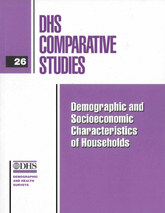- FEATURED

All DHS surveys collect household and respondent characteristics to serve as key background indicators for comparing data and viewing trends among countries and over time.
Household versus respondent characteristics: What is the difference?
Household characteristics include the household composition (how many people per household and their ages), educational attainment of household members, and school attendance ratios. Data on housing characteristics are also collected, including availability of electricity, water and sanitation facilities, as well type of flooring material and cooking fuel. Surveys also assess ownership of various durable goods, such as radio, television, refrigerator, bicycle, car and telephone.
Wealth is a household characteristic that often has a large affect on health. DHS separates all interviewed households into five wealth quintiles to compare the influence of wealth on various population, health and nutrition indicators - the wealth index.
Respondent characteristics provide basic demographic information about the survey respondents, including age, marital status, region of residence, level of education, religion and ethnicity. Educational attainment and literacy of respondents, access to mass media, employment status and occupation are also provided. This section also contains a series of questions related to women's empowerment, including who decides how women's earnings are used, women's participation in decisionmaking, and attitudes towards wife beating.
Related Indicators
- Household population by age and sex
- Household composition (Head of household and number of members)
- Fosterhood and orphanhood
- Educational level of household population
- School attendance
- Housing characteristics (Electricity, source of drinking water, sanitation facility, flooring, wall and room material, rooms for sleeping)
- Household durable goods (e.g. car, radio, television, bicycle…)
- Respondent background characteristics (women and men): age, marital status, region of residence, education, religion
- Respondent level of education by background characteristics
- School attendance and reasons for leaving school
- School attendance ratios
- Grade repetition and dropout rates
- Exposure to mass media
- Employment
- Employer and form of earnings
- Occupation
- Decision on use of earnings
- Child care while working
- Literacy
- Decision on use of earnings and contribution of earnings to household expenditures
- Women's control over earnings
- Women's participation in decision making
- Women's participation in decision making by background characteristics
- Women's attitude toward wife beating
- Women's attitude toward refusing sex with husband
